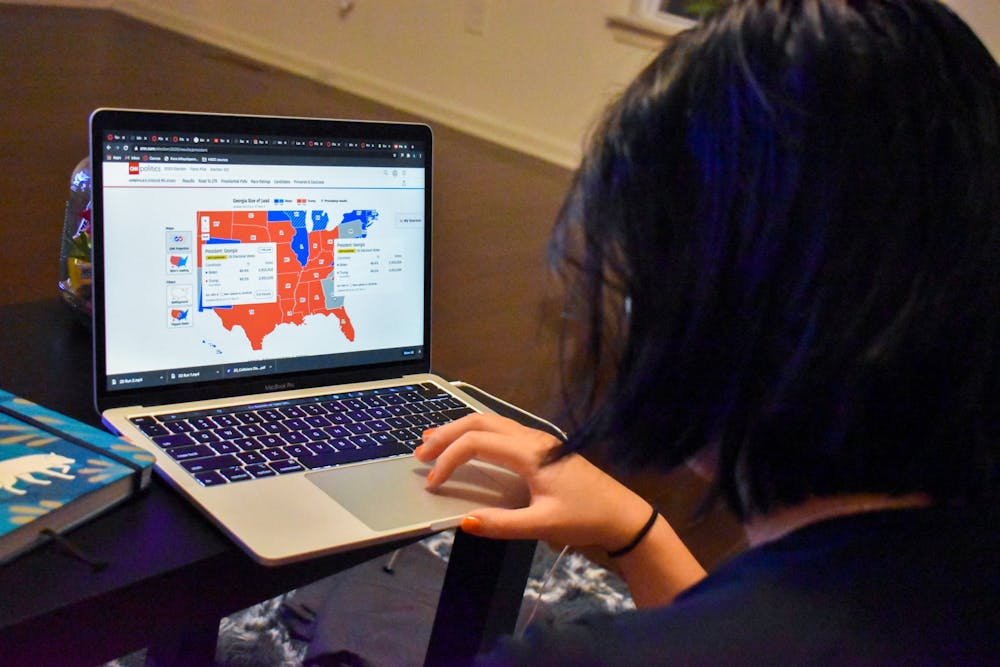Election week has been a stressful time for most Penn students. Personally, I’ve been refreshing FiveThirtyEight every ten minutes, looking for Biden’s leads to turn into a Biden victory. However, a voter’s perspective of the election depends a great deal on who they voted for. Even as Joe Biden appears to be on the verge of victory, more than half of Trump supporters think that Trump has won. Though Fox News and several prominent Republicans are pushing back against Trump’s claims of voter fraud, still others have sided with him. Although disinformation has been especially prevalent over the past few days, our troublesome relationship with the truth runs far beyond one election.
Are bad things really happening in Philadelphia? Like I’d know — though I’m a freshman at Penn, I’ve never even set foot in Philly. If I didn’t live in New York City, maybe I’d believe it when Trump says that NYC has become an anarchist jurisdiction slash ghost town.
But say I want to disprove any of this — how do I do it? Crime rates in NYC are increasing. The City Council did cut $1 billion from the police department. Does this mean that NYC is lawless? I don’t think so, but it’s a subjective question. There’s no set of standards a city has to meet to not be anarchist. Media coverage isn’t much help either. For each image of New Yorkers partaking in peaceful outdoor dining, there’s another of police cars aflame.
In the information age, you’d think that it would be easier to find just that — information. And yet, the sheer amount of information available means that anyone can cherry pick the facts that they agree with while ignoring everything else. The term “mainstream media” encompasses both CNN and Fox News. So in April, when Fox News’ Laura Ingraham called hydroxychloroquine a “game changer” and CNN wrote that it leads to higher death rates, who was the average American citizen supposed to believe? At face value, both sources ought to be equally credible.
Many newscasters have been accused of distorting facts to invoke fear and paranoia in their audiences. This distortion may be why opposing parties view each others’ ideologies as far more extreme than they actually are, or why each party has accused the other of living in an alternate reality. In this turmoil, some Americans have given up on identifying facts altogether. And I get it. When there is hardly any consensus across parties, it can be exhausting to defend every single belief.
Even so, we cannot afford to give up on the truth. When we do, we risk becoming victims to a “firehose of falsehood.” Under this propaganda model, it doesn’t matter how obvious a politician’s lies are. It takes longer to disprove lies than to create them, so if all media is flooded with lies, it becomes near impossible to find the truth amidst the resulting confusion and chaos. The firehose of falsehood is widely used in Russia, and typical countermeasures against it prove useless. After all, how do we protect truth when we can’t agree on what the truth is?
In the United States, some have proposed media literacy initiatives that would help Americans identify bias and credibility in their media and craft arguments of their own. Media literacy should absolutely be a part of every school’s curriculum, and promoting it could help prevent crises of truth in the future. But in the short term? Imagine trying to teach a QAnon supporter about media literacy. They would ignore you at best, and feel attacked at worst. To someone who regularly reads questionable sources, it is extremely holier-than-thou to suggest a “right” way to read the news, even with good intentions.
In addition, while media literacy is certainly useful for identifying satire, sponsored articles, or sketchy social media posts, that’s not the disinformation that enthralls the most Americans. The most dangerous ideas are the ones composed of morsels of truth that have been exaggerated beyond recognition. The most dangerous ideas come from politicians and reporters with considerable ethos, who can broadcast false claims on a large scale.
SEE MORE FROM CAROLINE MAGDOLEN:
Come Thanksgiving, maybe you should talk to your “Crazy Uncle”
COVID-19 has stolen our friendships from us. Let’s take them back
The disinformation crisis facing the United States does not have simple solutions. Who am I to say that I know the truth, or that I could filter out all of the “fake news?” Is there anyone that can do that?
Searching for the truth is a disorienting struggle that can leave you questioning if anything is undoubtedly true, and maybe that’s the problem. We like certainty, especially in as uncertain times as now, and the media is pressured to deliver. Remember how confirmation bias wrecked election forecasts in 2016? Sometimes when we seek truth and certainty, we find (false) comfort in declarative statements from popular media. For some, that’s overconfident forecasts from the New York Times, but for others, that can mean seeking solace in famous armchair theorists like Alex Jones.
Disinformation isn’t going away anytime soon, and there aren’t any clear, unbiased solutions to it. But we can cope with it better if we stop expecting certainty from our news, and strive to identify probable truths, as opposed to an absolute, undeniable one. Once in a blue moon, conspiracies have merit, and fake news is nothing new to this country. These statements, if anything, are the truths we have to accept going forward.
CAROLINE MAGDOLEN is a College and Engineering first-year student studying Systems Engineering & Environmental Science. Her email address is magdolen@sas.upenn.edu
SEE MORE FROM CAROLINE MAGDOLEN:
Come Thanksgiving, maybe you should talk to your “Crazy Uncle”
COVID-19 has stolen our friendships from us. Let’s take them back









